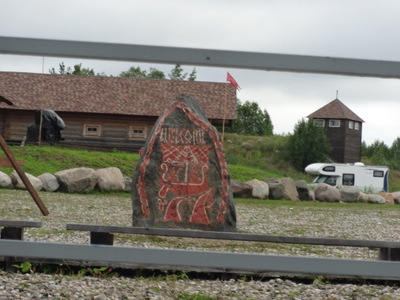
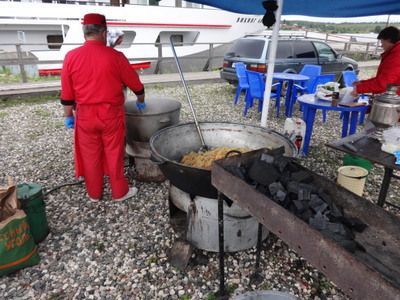 Going ashore, we were greated by this painted stone. I couldn't read the inscription which didn't even look like Cyrillic. Perhaps runes. Looked pretty Viking to me (in the sense of marauding norsemen rather than a modern cruise line).
Going ashore, we were greated by this painted stone. I couldn't read the inscription which didn't even look like Cyrillic. Perhaps runes. Looked pretty Viking to me (in the sense of marauding norsemen rather than a modern cruise line).Sunday, 6 August, Kuzino and the monastery (and the school)
Written 4 September 2017
The morning's breakfast innovation was small chunks of honeycomb on the buffet.
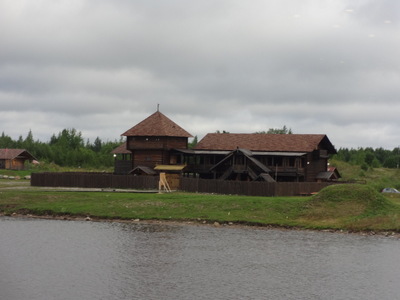

We pulled into Kuzino about 8:45 p.m. after again cruising all afternoon and all night. Our first view of the town was this rustic structure surrounded by a wooden palisade.
It forms part of a cluster of such structures (right-hand photo) located right by the cruise-ship quai.
As we were being moored, I could see a few people in period dress (a really old period, like animal skins, sack cloth, and sandals) walking back and forth. I'd say were too early in the morning for the festivities, but they were clearly gearing up for some sort of reenactment for tourists.

 Going ashore, we were greated by this painted stone. I couldn't read the inscription which didn't even look like Cyrillic. Perhaps runes. Looked pretty Viking to me (in the sense of marauding norsemen rather than a modern cruise line).
Going ashore, we were greated by this painted stone. I couldn't read the inscription which didn't even look like Cyrillic. Perhaps runes. Looked pretty Viking to me (in the sense of marauding norsemen rather than a modern cruise line).
In addition, under a big blue canopy, guys in orange jumpsuits were preparing vats of food (that's the Akun behind them). The kettle I could see into was full of a rice, meat, and carrot mixture. Did Vikings eat rice?!
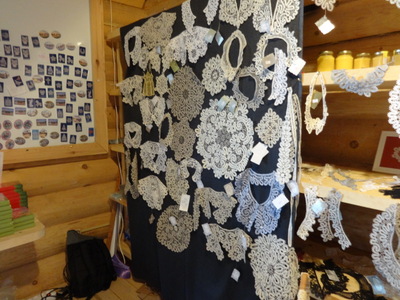
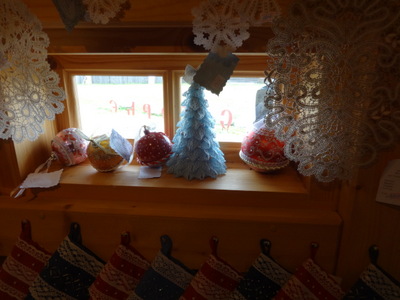 One of the log buildings was a lace and embroidery shop, which opened in time for us to explore it before the buses left for our excursion at 9 a.m.
One of the log buildings was a lace and embroidery shop, which opened in time for us to explore it before the buses left for our excursion at 9 a.m.
Most of what they carried was handmade bobbin lace, like the examples in the photos. I especially liked the little Christmas trees made from long folded strips of lace pinned to cone-shaped forms (probably styrofoam).
They also sold lovely hand embroidery, mainly of table linens and dish towels, like the ones at the left below. This was (and still is, I guess) a flax-growing region, so all of the textiles were made of linen, not cotton. I made our assigned bus, but Rachel was busy buying a tablecloth, and they had to hold the last bus for her.
Written 5 September 2017
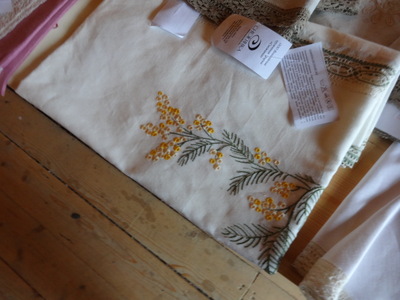
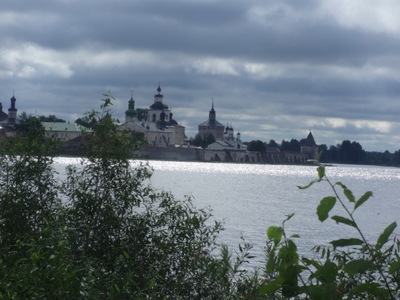 Our first destination of the day was the Kirillo-Belozersky monastery, which translates as "St. Cyril's Monastery on White Lake." But it's not actually on White Lake—the body of water this handsome view of it was taken across is actually Lake Siverskoye. The real White Lake is nearby and apparently turns white seasonally. (Glacial till stirred up by the spring overturn? The never explained.)
Our first destination of the day was the Kirillo-Belozersky monastery, which translates as "St. Cyril's Monastery on White Lake." But it's not actually on White Lake—the body of water this handsome view of it was taken across is actually Lake Siverskoye. The real White Lake is nearby and apparently turns white seasonally. (Glacial till stirred up by the spring overturn? The never explained.)
As usual, as we traveled by bus from the Kuzino landing to the town of Kirillov, where the monastery was located, we were lectured on the local history and culture. We had, we learned, left Yaroslavl Oblast, the administrative territory where our last two destinations are located, and entered the Volga Oblast, the largest in Russia (as big as Denmark, Belgium, Switzerland, and some fourth small country I didn't catch, all put together).
Anyway this was once the largest monastery, and the strongest fortress, in northern Russia. St. Cyril himself walked here from Moscow (at age 60) to found it in 1397, and he lived here for the next 30 years. Legend says that Mother Mary came to him in a dream and told him to go look for the "perfect place" to found a monastary. In truth (our guide told us), the czar sent him, because Russia needed a fortress controlling access along the Volga to keep the Vikings out of Moscow. The place he chose took the name Kyrillov in his honor. As it turned out, the fortress was built too late; the Vikings never came back, and no one ever attacked it. Catherine the Great forbade anyone in the town to build anything higher than four stories lest it block the pictureque view of the monastary buildings. On the other hand, despite her conversion, she thought like a lutheran. She pointed out that the business of nun and monks was prayer; they didn't need all that stuff, so she often confiscated churches; wealth and precious objects.
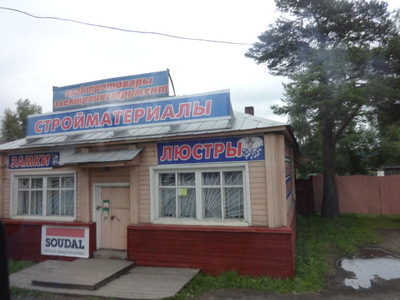
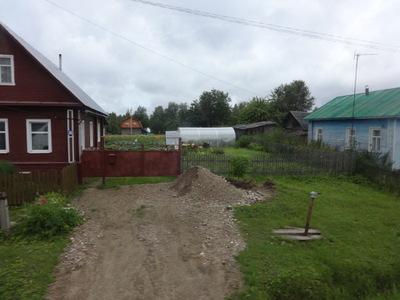 About 1200 people live here now, not counting summer people; they're mostly retirees, because (as we were told by every guide, in every venue, all day) the place has no industrial enterprise to provide jobs; young people leave to find work. In Winter, there's ice fishing, hunting, sleeping, skiing, winter swimming; summer, all the locals work either in the monastary (about 200 people), for the local electrical company about 500 people, providing power for several districts, or the local craftman's coop (bakers, sausage makers, etc., about 200 people).
About 1200 people live here now, not counting summer people; they're mostly retirees, because (as we were told by every guide, in every venue, all day) the place has no industrial enterprise to provide jobs; young people leave to find work. In Winter, there's ice fishing, hunting, sleeping, skiing, winter swimming; summer, all the locals work either in the monastary (about 200 people), for the local electrical company about 500 people, providing power for several districts, or the local craftman's coop (bakers, sausage makers, etc., about 200 people).
The building in the left-hand photo is the bakers; shop. That on the right is another house, with a big garden plot out back.
The region includes about 100 local small lakes, and several small rivers, which harbor 1000 species of fish.
Many men are occupied in fishing and hunting; hunting season is 10 days, twice a year. In the spring, ducks and geese only; from August to the end of October, elks, wolves, foxes, bears, and something else I didn't catch.
The town hosts an annual festival of flaxen goods (including the local Volga lace). Clay and birchbark products are also featured. It's traditional for teachers to learn to make various craft articles then to teach the school children.
Lake Siverskoye is deep (26 m) and is about 6 km long by 3 km wide. Even today, many of the houses have no central heading or "central water" and draw their water from the lake. They heat with stoves. Not sure what "central water" means—I guess they're not connected to a city water system but pipe in their own?
In the monastery's heyday, merchants lived in the town; their houses were usually two-story with shops below and living above. The part of town we passed through is called "upsharl." It includes a well-known music school for children and a "creativity institute" for children.
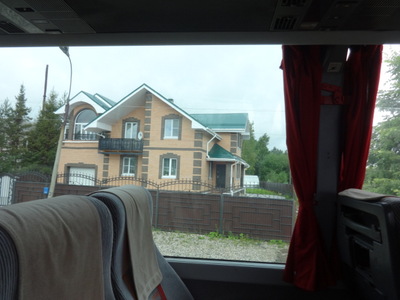
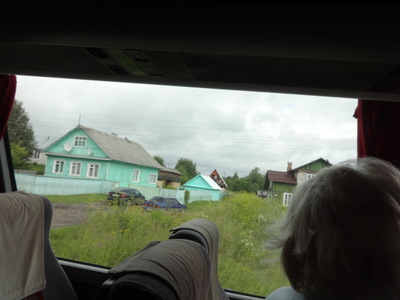 Here are a couple of the houses we passed in Kirillov. Some were brick and some wooden. All have vegetable gardens.
Here are a couple of the houses we passed in Kirillov. Some were brick and some wooden. All have vegetable gardens.
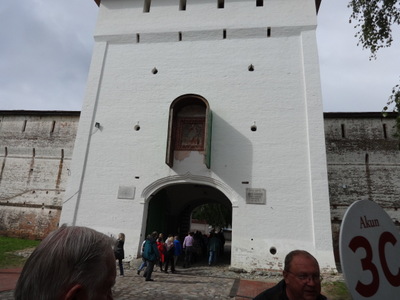
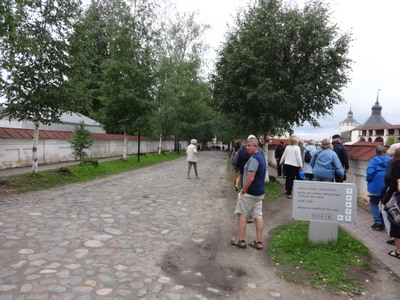 The left-hand photo shows the outer gate through which we entered. A small gate was opened daily and the large one only on special occasions or for special guests. At the lower right corner, you can see the face of our local guide, Andrey. He offered himself as a prototypical example of the local physiognomy, as he's a direct descendent of the original Finno-Ugric population of the region. He said 10,000 slavonic and Finno-ugric people lived here, coexisting peacefully, when the Vikings showed up. The Vikings gave up on conquest of the region, but some stayed on and joined the local population.
The left-hand photo shows the outer gate through which we entered. A small gate was opened daily and the large one only on special occasions or for special guests. At the lower right corner, you can see the face of our local guide, Andrey. He offered himself as a prototypical example of the local physiognomy, as he's a direct descendent of the original Finno-Ugric population of the region. He said 10,000 slavonic and Finno-ugric people lived here, coexisting peacefully, when the Vikings showed up. The Vikings gave up on conquest of the region, but some stayed on and joined the local population.
The outer wall is about 1.5 miles long and encloses not just the monastery buildings but large gardens, military barracks, etc. The fortress was built in the 17th century, over a period of 30 years. St. Petersburg didn't exist yet, so this fortress was the eastern rampart of Russia. It was also a huge employer and economic center; it had lots of slaves (i.e. serfs).
At its height, the monastary had 800–900 inhabitants: 250 monks, a bunch of soldiers, craftsmen, and some prisoners in prison cells. It had a huge library—a thousand hand-made books by the 16th century. Ten monks live here now. They sell fish and vegetables. At one time, the monks salted 1500 kg of black caviar per year for sale. They ate none of it themselves, because they were strict vegetarians and didn't even drink beer. (A small, small, dark-colored onion dome was pointed out to us as the refectory.) I'm not sure whether they still produce caviar today, but the modern monks eat fish in addition to vegetables, plus one chicken egg each at Easter. The guide told us that when the Tsar visited at some point, he said of the dishes in front of him, "Bread is everything, but no bread is better than no fish." Needless to say, they immediately served him a fish. I don't know whether that was the point at which the monks also started eating fish.
We were shown a building used as a school for the children of criminal families (actually political-prisoner families). In addition to an eclesiastic center, the monastery served as a hospital and a prison. The criminal prisoners probably fared better in prison than out, but political prisoners were treated worse.
A large rectangular building, last renovated in 1829, served as treasury chamber of the monastary, armory, and library. The monks' cells date from the last quarter of 17th century. Inside the outer courtyard, the walls were lined with stables and military barracks.
We followed the long straight pathway shown in the right-hand photo across the large enclosure to the gates of the monastic buildings. Birch trees lining the pathway, many planted in 1897. The linden trees were still in bloom; the ones in Moscow were in fruit; we were much farther north than Moscow.
At 10:40 a.m., the bells rang for mass; they do two masses a day during the week and all day long on Saturdays and Sundays.
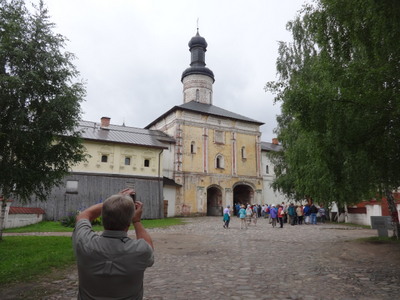
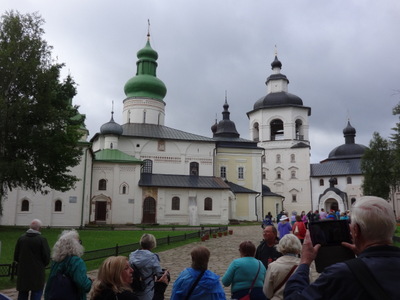 Here's the inner gate. In 1585, a local monk named Alexander painted the frescos to either side of it. To the right, archangel holds a long scroll on which he writes all your sins as you enter. On the left, another holds a large sword with which he cuts them off as you pass. You therefore enter the monastic enclosure free of your sins. When you leave again, you're free to start accumulating new ones!
Here's the inner gate. In 1585, a local monk named Alexander painted the frescos to either side of it. To the right, archangel holds a long scroll on which he writes all your sins as you enter. On the left, another holds a large sword with which he cuts them off as you pass. You therefore enter the monastic enclosure free of your sins. When you leave again, you're free to start accumulating new ones!
The central part of the monastic complex, with the green domes, was formed very slowly over 400 years; the first part of it was built in 1497.
The broad white bell tower was added at the end of the 17th century. Originally it held 50 tons of bells. The largest was 22 tons, and you could hear it 15 miles away (I think he even said "against the wind"). Unfortunately, the bells were confiscated at least five times, for various reasons, mainly wars, when metal was needed for cannons. The tower has no bells today.
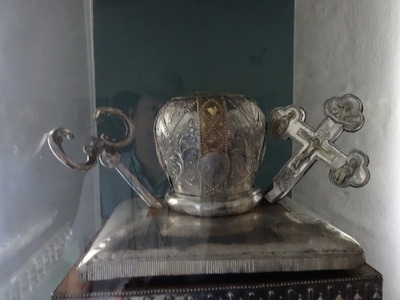
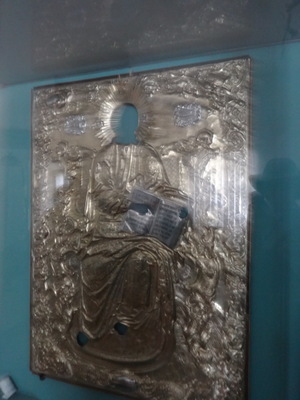 Inside the monastery's museum building, I took lots of photos, but they are pretty uniformly useless. The glare from the windows was fierce, and everything was framed behind glass. The holdings were mostly icons and silver religious objects.
Inside the monastery's museum building, I took lots of photos, but they are pretty uniformly useless. The glare from the windows was fierce, and everything was framed behind glass. The holdings were mostly icons and silver religious objects.
At the left here are silver items used during religious services (I think).
At the right is a silver frame for an icon. Most of the panel is a gilded silver image of a saint indicating a passage in a book, but the face and neck are missing. That's where the actual icon would have fit—a painting of the saint's face and neck. Such icon frames were very common in the museums of silver work and religious objects we were shown and ranged from small silver frames surrounding large icons to cases like this, where the frame dwarfed the icon itself.

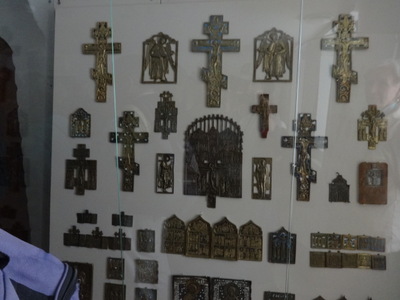 I don't know whether this beautiful silver model is of one of the monastery building here or of some other church.
I don't know whether this beautiful silver model is of one of the monastery building here or of some other church.
The crosses on this wall illustrate the distinctive Russian Orthodox form, which includes a second, tilted crosspiece low on the cross. It supposedly indicates the two men who were crucified with Jesus. the one to his right repented, so the crosspiece on that side points upward toward heaven. The one on the other side did not, so his end points downward, toward hell.
An ornate pair of gilded doors come from the Moscow Kremlin workshop. Michael Romanov donated them. As a three-year-old, he was exiled to a convent in this region and remembered it as the happiest time of his life.
The silver and gold of the icon settings, crosses, and ornate doors did not come from Siberia; it came from the New World. Some was imported as precious metal; the rest through trade. Russians sold things to people with silver and gold coins (e.g., the Portuguese), then melted the coins for decorative use.
Another source of the monastery's income was personal gifts and bequests. A duke of Moscow (who later became St. Basil) Was married for 19 years, but his wife was barren. He sent her off to a nunnery and took a second wife, young and pretty. She was barren as well. The couple came to this monastery prayed for a son for two weeks in 1528. A son was born a year later (1530; Andrey said, "who knows who the real father was"). In gratitude, they donated a lot of money to the monastary, which paid for two churches and a bunch of icons. The son grew up to be Ivan IV (the Terrible). Andrey claimed he tried twice to marry Elizabeth I of England but was refused (but then, so was everybody else).
Women could not write books or icons. Embroidery was their only employment; so nuns did a lot of it. Some of the embroidery we saw displayed took 12 days per square inch. The shroud of St. Cyril took three people two and a half years. In addition, every priest needed many vestments—white for easter, gold and silver for Christmas, blue for the virgin—so demand for embroidered goods was high. On round embroidered piece had never been restored, only cleaned a little, and its colors were still incredibly bright and rich.
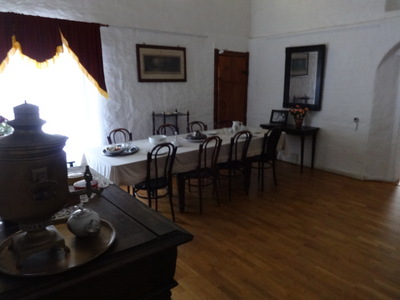
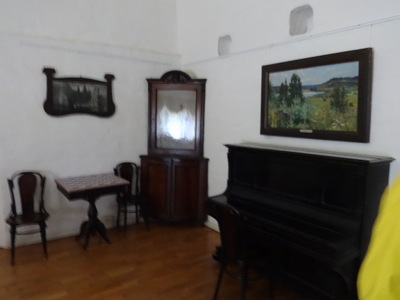 We passed this room on our way from one gallery to another, and I ducked inside to get a look. I don't know whether it's a restoration, intended to show a typical room of a certain period, or whether it's, e.g, the break room for museum personnel.
We passed this room on our way from one gallery to another, and I ducked inside to get a look. I don't know whether it's a restoration, intended to show a typical room of a certain period, or whether it's, e.g, the break room for museum personnel.
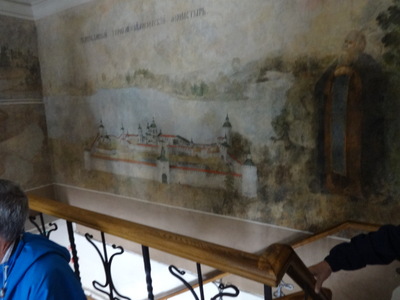
 We paused in a stairway to see these frescoes that depict aerial views of other monasteries in the region. The one at the left might even be the monastery we were in, but I'm not sure.
We paused in a stairway to see these frescoes that depict aerial views of other monasteries in the region. The one at the left might even be the monastery we were in, but I'm not sure.
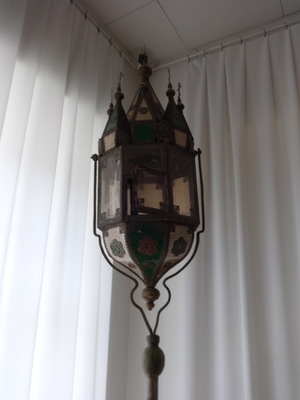
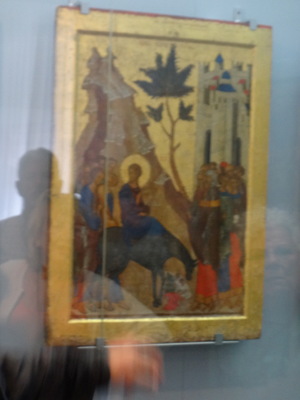 In the corner of another gallery stood this ornate 17th century processional lantern. After asking whether anyone recognized it (no one did), the guide revealed that a monk who had traveled to England in that century had appropriated and brought home an ordinary oil-burning London street lamp for the purpose.
In the corner of another gallery stood this ornate 17th century processional lantern. After asking whether anyone recognized it (no one did), the guide revealed that a monk who had traveled to England in that century had appropriated and brought home an ordinary oil-burning London street lamp for the purpose.
In one of the last galleries we visited, we were shown this large icon, which has been declared (by those who study such things) the best icon in the world depicting the entry into Jerusalem. Despite scholars' high opinion, however, our guide pointed out that the artist had clear never seen either a palm tree or a donkey.
The collection included icons from the 17th century, a few signed icons (rare among very early icons, as a signature was considered a sign of vanity on the party of the monks who painted them), and Byzantine Greek-style icons.
Early on, churches had many, many wooden carvings, but later those were considered primitive and were strongly discouraged ("not forbidden, but not permitted," according to Andrey), so most are gone., but this museum retains some.
One unique icon from 1630 shows a vertical trinity in which God is protrayed as a person. All the others were destroyed in the 17th. This one was hidden in an attic, because it was expensive and the monks hoped it might come back into fashion and would save their having a new one painted. It was rediscovered just 28 years ago.Andrey also touched on some of the differences between the Orthodox and Catholic churches. For example, in Orthodox crucifixes, Jesus is fixed to the cross by four nails (one in each foot) but in Catholic crucifixes, by only three (one through both feet). These details are very important to church doctrines. In fact a huge schism within the Orthodox church, which amounted at one time to open warfare and persists to this day (though more peacefully) is that between old believers and new believers. In the mid-17th century, Patriarch Nikon concluded that the Russian church had strayed from its original principles, which were based on the Greek church, introduced reforms intended to bring them back more closely in line. Big mistake. The differences were numerous, but the split came to be symbolized by whether a believer crossed himself with two fingers or with three. The Wikipedia entry on "old believers" shows a photo of a famous painting of an old woman being dragged to the scaffold while defiantly holding up two fingers.
In one crucifix in the museum, produced locally, Jesus has a very Mongol face. Guide Andrey claimed that it was the artist's assertion that we are all one one people in Jesus' eyes.
On one long wall, black and white thumbnail images represent the current hypothesis of the original arrangement of the church's iconostasis; of 60 icons, only 3 are missing. It's the only full icon stand from the 16th century.
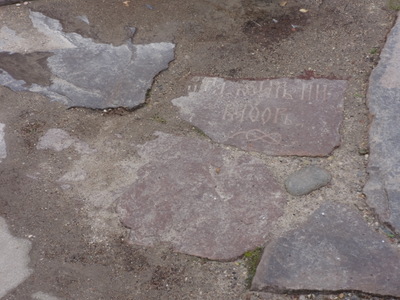
 Back outside, our guide showed us these gravestones, which have been incorporated into the pavement of one of the walkways outside the church. During the communist era, when churches and monasteries received no funding from government, the gravestones were reused in this way. The monks apparently did not regard the practice as a desecration but as a chance for them and their predecessors to be useful to the community even after death. Old worn-out millstones were also used; we saw them mixed in with the grave markers. Andrey says hundred of wind and water mills dotted the area, so you find old millstones incorporated into many stone structures.
Back outside, our guide showed us these gravestones, which have been incorporated into the pavement of one of the walkways outside the church. During the communist era, when churches and monasteries received no funding from government, the gravestones were reused in this way. The monks apparently did not regard the practice as a desecration but as a chance for them and their predecessors to be useful to the community even after death. Old worn-out millstones were also used; we saw them mixed in with the grave markers. Andrey says hundred of wind and water mills dotted the area, so you find old millstones incorporated into many stone structures.
In a separate plot, beside the path, were these elaborate tombs, those of merchants from the town who could afford to purchase the right to be buried here. A burial plot down in the village would normally go for about 50–60 kopecs, i.e. less than a ruble. In this small cemetery inside the monastary walls, wealthy merchants could be buried with nice little marble monuments for about 300–400 rubles.
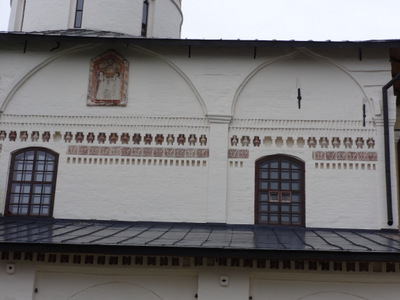
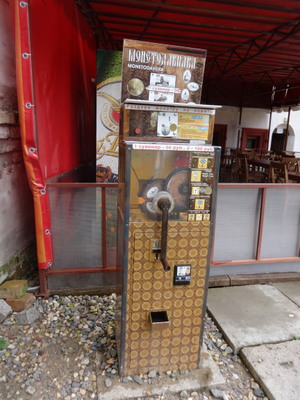 On our way out, the guide pointed out this ornamentation on the side of a building. He explained that builders and masons from different regions of the country adopted signature details to mark their work. This design of a row of small columns framing tiled recesses above a tiled frieze was typical of workers from Moscow. He pointed out other details on other buildings that indicated they were constructed by workers from other regions.
On our way out, the guide pointed out this ornamentation on the side of a building. He explained that builders and masons from different regions of the country adopted signature details to mark their work. This design of a row of small columns framing tiled recesses above a tiled frieze was typical of workers from Moscow. He pointed out other details on other buildings that indicated they were constructed by workers from other regions.
Finally, we spotted this classic hand-cranked machine that we could have used to press a coin into a souvenir token of the location. We didn't, and we regretted that later, as it was the only such machine we encountered on the whole trip, so we weren't able to bring home a token to close friend Michael Budman, who collects them.
Guide Andrey told us several jokes. For example, "How many kinds of vodka do we produce in Russia? Answer: Good Vodka and better vodka. Another example: "Who was the most important general in all of Russian history? Answer: General frost." "Hitler was a fool to attack us," he added, "and only 10% of Napoleon's army made it home to France."
A propos of some question, he told us that the beginning of May is great fishing season, but it's also the time to plant potatoes and work in the garden, so Russian men are conflicted. He called it the time when the birch leaves are tiny. (In the U.S., we say it's the time when oak leaves are the size a squirrel's ear.)
I saw one small passerine bird. Andrey didn't see it before it flew off, but he said it was probably a "tressagooska." (Back at the ship, I had the receptionist look that up for me on line, but it turns out to mean wagtail, which this bird definitely wasn't. After poking around on the web myself, I think it was probably a female chaffinch.

 Our next stop was a nearby school, about a quarter of an hour away by bus. Here it is, at the left, looking enough like public schools the world over to give me the heebie-jeebies at 500 yards. This one, being the only school in the town, houses first grade through high school.
Our next stop was a nearby school, about a quarter of an hour away by bus. Here it is, at the left, looking enough like public schools the world over to give me the heebie-jeebies at 500 yards. This one, being the only school in the town, houses first grade through high school.
Inside, we were ushered into a classroom, where we took seats at the desks. School was out for the summer, of course, but a student had come in to act as our guide, give a short presentation, and answer questions.
820 students attend this school, in split shifts. They start at age 6 or 7 and finish at 17. The school has 56 teachers, who assign the students 3–4 hours of homework a day. Every pupil probably has a computer at home, and every student has one at school. It's a public school; so nobody pays to attend. Textbooks belong to the school library and are loaned to the students for the year, free of charge. Classes are typically 25–30 pupils. A village school we'll pass near Galitsy has 130 pupils.
Students choose among English, German, and French as a foreign language. They have exams after 9th and 11th grades. All academic subjects are compulsory but others can be added on top, like art. Girls can't take shop.
Until recently, English was started in the 5th grade; now they're starting it earlier, in the 2nd grade. Our guide wants to go to univewrsity to become a teacher of history and social studies.
Education is divided into primary, basic, and higher. The students have a week's vacations in fall, two weeks at Christmas, a week in spring, and 3 months in summer. During the summer, students might go camping, to a family dacha, or to summer camp. They are given a summer reading list of ca. 15 books.
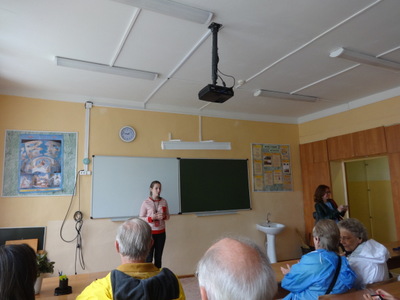
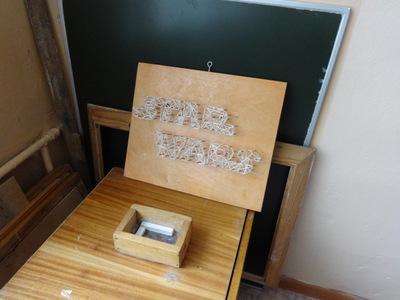 That's our student guide in the red and white stripes. The classroom just looked like a classroom to me, but Rachel, as a retired teacher, has a sharper eye for educational detail than I do. She wanted to know whether all the classrooms had smartboards or just this one. (Answer: yes, they all do.)
That's our student guide in the red and white stripes. The classroom just looked like a classroom to me, but Rachel, as a retired teacher, has a sharper eye for educational detail than I do. She wanted to know whether all the classrooms had smartboards or just this one. (Answer: yes, they all do.)
As we left the classroom to continue our tour, I got a shot of this little art project, sitting in a corner. Many of the walls and stairways were papered with student art, and I was very impressed with the quality of the drawing and painting.

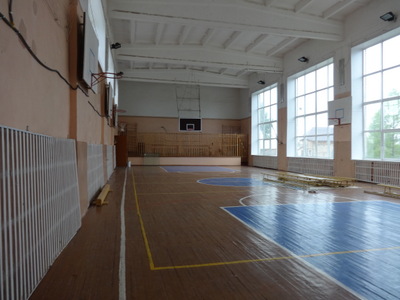 Ev spotted this case of trophies in the lobby and asked what they were for. The school competes against others up to 60 miles away in sports, e.g. soccer, basketball, and volleyball, and the trophies were for various sports victories.
Ev spotted this case of trophies in the lobby and asked what they were for. The school competes against others up to 60 miles away in sports, e.g. soccer, basketball, and volleyball, and the trophies were for various sports victories.
The lobby walls also bore photos (not visible in this shot) of graduates and (in a separate group) school leavers killed in Chechnya and other wars.
The gym floor was painted for a full basketball court, and the sides were lined with additional baskets for half-court play, but we saw no accommodation for spectators. The benches set out on newspapers at the right-hand side looked as though they'd just been painted. The object on the floor at the left, at the foot of the radiators, might have been a balance beam.

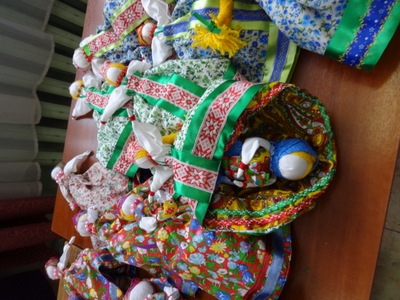 Finally, in another classroom, with one end decorated as a stage, another student, dressed in regional costume, sang a couple of folk songs and accompanied herself on one of those wooden rattle instruments we saw in Moscow.
Finally, in another classroom, with one end decorated as a stage, another student, dressed in regional costume, sang a couple of folk songs and accompanied herself on one of those wooden rattle instruments we saw in Moscow.
Along the side of the classroom long tables were laid out with crafts for sale, which our student guide demonstrated. I was most impressed with a collection of reversible rag dolls. They illustrated a series of life passages. The most popular were young women dressed in gay colors with their hair in braids that, when turned upside down and the skirt turned inside out, transformed into middle-aged married women is more somber color with their hair restrained by kerchiefs. Others transformed middle-aged women into grandmothers, red-riding-hood's grandmother into the wolf, and Cinderella from rags to her ball gown. Not so practical to show such transformations for men, as the reversal depended on the dolls' long skirts. One especially impressive doll reversed four ways, to reveal spring, summer, fall, and winter.
Other offerings include painted greeting cards and bookmarks. I bought a laminated bookmark incorporating pressed leaves and flowers.
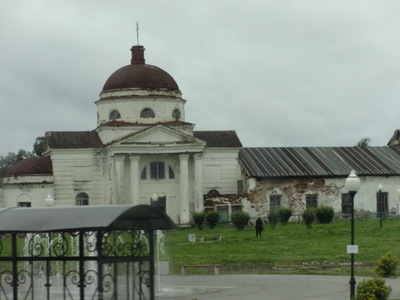
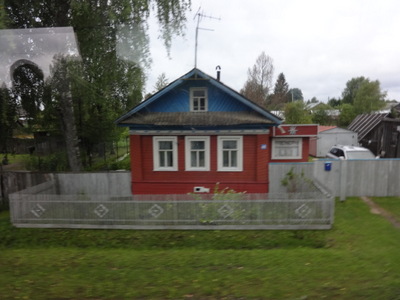 After the monastery and the school, we never returned to Kuzino. The ship had cast off about 10:45 a.m. and arrived in Goritsy about noon, in time to meet our buses there. The white building in poor repair in the left-hand photo is the old House of Creativity for children, now replaced by a new one. There's also a theater club for children.
After the monastery and the school, we never returned to Kuzino. The ship had cast off about 10:45 a.m. and arrived in Goritsy about noon, in time to meet our buses there. The white building in poor repair in the left-hand photo is the old House of Creativity for children, now replaced by a new one. There's also a theater club for children.
The right-hand photo is another house, with its garden plot in front.
The town is served by a local hospital with dentists and pediatricians. Because of the lack of employment, many of the residents here are nonnative retirees. Peter the Great put in canals (we crossed one on a small bridge) to help transport the region's lumber to Moscow, but that industry has waned. No public transport serves the town, so people have cars; kids walk or are driven to school; in half an hour, you can walk from one end of town to the other.
When the lakes and rivers freeze in winter, people can only get here by car or bus; the average summer temperature is 25°C. This is a very cold and rainy summer; the growing season is very short, so people start seedlings indoors and transplant them out in late May in "special small greenhouses" (cold frames?).
Local people pick mushrooms and wild berries: billberries, cranberries, blueberries, and goldberries. A cranberry drink is considered the best treatment for a cold.
Goritsy is the gateway for tourists in the region. Only 300 people live here, in old houses with kitchen gardens. About 20 pupils attend the local school. Half the region is a natural park to preserve the forests; a local orchid, a lady slipper, is the symbol of the park. According to legend, a beautiful lady lost her slippers in the forest here. A witch tried to wear them, got frustrated when they didn't fit, and threw them. Where they landed, lady slippers grew.
A nunnery was established here by the aunt of Ivan the Terrible, after he killed her son and forced her to become a nun.
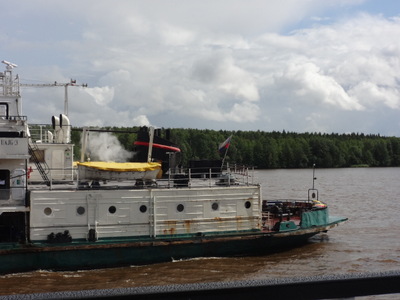
 In Goritsy, to reboard the ship, we had to cross two others, including the Tolstoy. Almost as soon as we sat down to lunch at 12:30, the ship cast off again, this time headed for Kizhi island, which we wouldn't reach for 26 hours!
In Goritsy, to reboard the ship, we had to cross two others, including the Tolstoy. Almost as soon as we sat down to lunch at 12:30, the ship cast off again, this time headed for Kizhi island, which we wouldn't reach for 26 hours!
We soon passed this barge/tanker. The left-hand photo shows it bow, and the left-hand one a view of it amidships. Speculation was that it carried liquified petroleum gas, which I could believe, given all those pipes and valves. It was, in fact, labeled (in transliteration), "Irkutsk Gas."

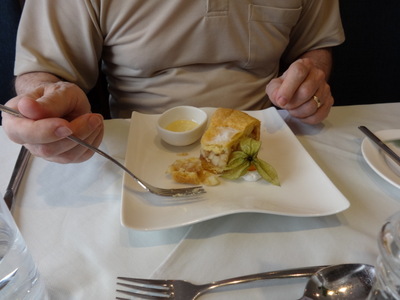 The featured items on the salad bar were quiche Lorraine and prosciutto with melon. I tried the former, which was just ordinary quiche Lorraine. None of the main courses appealed to me—Russian white cabbage soup with beef, dill, and sour cream; turkey cordon bleu with cranberry jam; and a club sandwich—so I had the maccheroni carbonara from the pasta station. I love carbonara.
The featured items on the salad bar were quiche Lorraine and prosciutto with melon. I tried the former, which was just ordinary quiche Lorraine. None of the main courses appealed to me—Russian white cabbage soup with beef, dill, and sour cream; turkey cordon bleu with cranberry jam; and a club sandwich—so I had the maccheroni carbonara from the pasta station. I love carbonara.
The first dessert was "sukoi frukte" ice cream coupe with caramelized dried fruits. I took that to mean "tutti frutti," and it was very good, but it's increasingly clear that this chef doesn't know the difference between "candied" and "caramelized"; it was just glacé fruit.
David had the other dessert, oven-baked apple pie with vanilla sauce, shown in the right-hand photo.
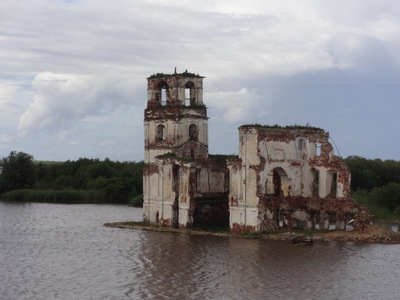
 From Goritsy, we crossed White Lake and entered the Volga-Baltic waterway. Along the way, we passed another of those unfortunate drowned towers, shown here on the right, but this one had a large bird on top! Even with binoculars and telephoto, it was hard to see, but I got one decent shot (not the one shown here, which shows the whole tower), that seemed to show a naked-headed vulture! I again consulted the book of nonpasserine birds, but I wouldn't work out which one it was likely to be.
From Goritsy, we crossed White Lake and entered the Volga-Baltic waterway. Along the way, we passed another of those unfortunate drowned towers, shown here on the right, but this one had a large bird on top! Even with binoculars and telephoto, it was hard to see, but I got one decent shot (not the one shown here, which shows the whole tower), that seemed to show a naked-headed vulture! I again consulted the book of nonpasserine birds, but I wouldn't work out which one it was likely to be.
Again, the afternoon was filled with lectures and demonstrations. I skipped tour escort Sasha's talk on "Mikhail Gorbachev and
Perestroika," but Rachel and I were there in a heartbeat for the live cooking demonstration. Chef Leonidas was in the Panorama Bar to show us how to make pelmeni!
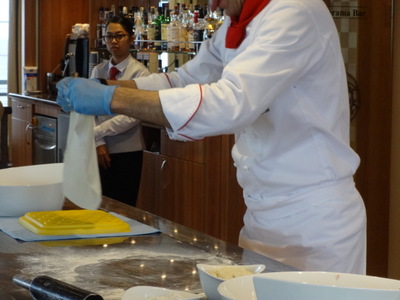
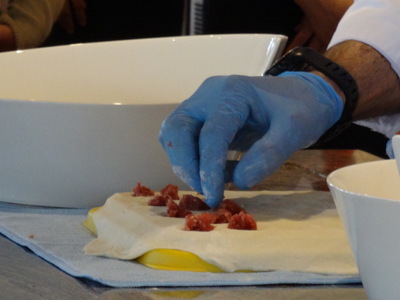 He gave us the recipe, neatly typed out so that we could follow along, then he proceeded to demonstration. First, he mixed and seasoned a combination of finely ground beef, finely ground pork, and finely copped onion. Then to rolled out a lump of the dough (which he had prepared ahead of time, because it has to rest before being rolled out). At this point, he explained that he had always made his pelmeni individually, by hand, has is traditional but that a chef friend of his had recently given him a pelmini plaque, a plastic device with hexagonal holes in it, designed to make 24 pelmeni at once. He proposed to try it out for the very first time on this occasion. That's it, the bright yellow thing, in the left-hand photo over which the chef is draping a sheet of rolled-out dough.
He gave us the recipe, neatly typed out so that we could follow along, then he proceeded to demonstration. First, he mixed and seasoned a combination of finely ground beef, finely ground pork, and finely copped onion. Then to rolled out a lump of the dough (which he had prepared ahead of time, because it has to rest before being rolled out). At this point, he explained that he had always made his pelmeni individually, by hand, has is traditional but that a chef friend of his had recently given him a pelmini plaque, a plastic device with hexagonal holes in it, designed to make 24 pelmeni at once. He proposed to try it out for the very first time on this occasion. That's it, the bright yellow thing, in the left-hand photo over which the chef is draping a sheet of rolled-out dough.
Next, he deposited a little dab of the meat mixture in the depression in the dough formed by each hexagonal opening. When they were all filled, he rolled out another sheet of dough, laid it over the filling, and rolled a rolling pin forcefully over the top, just as you would if forming ravioli in a ravioli plaque.
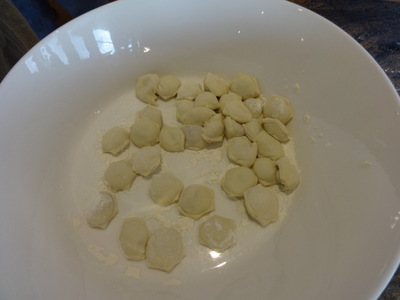
 Here, at the left, are the finished hexagonal pelmeni, dumped out into a bowl. The result was fairly satisfactory, except that many of them stuck to the plaque—the chef resolved, next time, to dust both the plaque and the dough more liberally with starch before proceeding.
Here, at the left, are the finished hexagonal pelmeni, dumped out into a bowl. The result was fairly satisfactory, except that many of them stuck to the plaque—the chef resolved, next time, to dust both the plaque and the dough more liberally with starch before proceeding.
Then it was time to demonstrate the "real" way to make pelmeni, by hand. He rolled out another sheet of dough and used a small round cutter (like a biscuit cutter) to cut out circles. In the right-hand photo he's showing an audience volunteer how to fold a circle of dough over a small piece of filling to form a half circle, which he pressed firmly closed. The recipe actually said to brush the edges of the circle with egg white to seal them, but the chef admitted that he just adds the egg white to filling and it seems to work just as well.

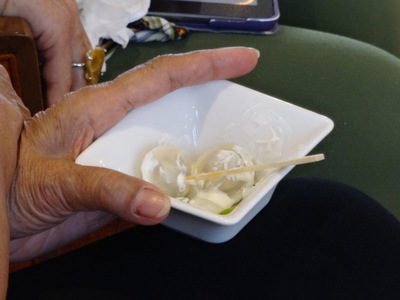 Once the sealed half circle is formed, he then pulls the corners together to form a rough circle and once again presses them together to seal. The left-hand photo shows a few of the finished circular pelmeni—much cuter than the hexagonal ones!—waiting to be boiled gently for 10 minutes or so.
Once the sealed half circle is formed, he then pulls the corners together to form a rough circle and once again presses them together to seal. The left-hand photo shows a few of the finished circular pelmeni—much cuter than the hexagonal ones!—waiting to be boiled gently for 10 minutes or so.
Finally, the chef's assistants brought out trays of dishes filled with cooked pelmeni, made beforehand in the kitchen and drizzled with sour cream so that we could all try them. Outstanding!
Next on the agenda was the "nautical talk" with the captain and his senior staff in the Sky Bar. It started with a video tour of the engine room, then continued with a question-and-answer session with the captain and mates. People asked about the qualifications required for their jobs (up to six years of college-level training), the ship's top speed (23 knots), the ships propulsion and maneuverability (three diesel engines, each directly driving, without a gear box, a propeller, plus a rotating bow thruster), and the ship's provenance (she was built, like most of her vintage in these waters, in East Germany and served a Russian cruise line under a different name until Viking bought her). I wish the session had been longer, as questions were still coming.

 Sunday's dinner featured a special, all-Russian menu. The starter choices were "Siliotka" (Russian salted herring with potato), "Stolichny salad" (a traditional salad of diced meat and mixed vegetables that has become an idiom in French, where it's called "salade russe," meaning a varied and indiscriminate mixture), tomato and cucumber salad with blue cheese and walnut dressing, and "Borsch" (Russian beef broth with beets, carrots, sour cream, and piroshki, i.e., tiny dumplings). As always, I went straight for the herring and Rachel for the soup. Ev had cheese, on this occasion Chechil Bohr (another smoked cheese) and Suluguni, a Russian semisoft, both from cow's milk. Rather than a chutney, this one came with a sour cream garlic sauce, which he ignored.
Sunday's dinner featured a special, all-Russian menu. The starter choices were "Siliotka" (Russian salted herring with potato), "Stolichny salad" (a traditional salad of diced meat and mixed vegetables that has become an idiom in French, where it's called "salade russe," meaning a varied and indiscriminate mixture), tomato and cucumber salad with blue cheese and walnut dressing, and "Borsch" (Russian beef broth with beets, carrots, sour cream, and piroshki, i.e., tiny dumplings). As always, I went straight for the herring and Rachel for the soup. Ev had cheese, on this occasion Chechil Bohr (another smoked cheese) and Suluguni, a Russian semisoft, both from cow's milk. Rather than a chutney, this one came with a sour cream garlic sauce, which he ignored.
From the main courses, David chose "Pojarsky Koteletti" (the left-hand photo), a slice of pork and chicken meat loaf crumbed and fried crisp, served with mashed potatoes and zucchini (traditionally, it's "veal Pojarsky," but pork and chicken are way cheaper).
I had the Russian "Koulebjaka," puff pastry stuffed with salmon and spinach (right-hand photo). Note the few pearls of pink salmon caviar in the cream sauce.
I didn't photograph what the Sinnetts ordered, so it must have been something I'd seen before, like the filet steak.
The desserts were "Sirniki," Russian curd blinis with strawberry mélange, and Russian honey cake. The strawberry mixture was good, but the blinis weren't—they were thick, stodgy, and unappealing, like heavy and sodden biscuits. Rachel had the honey cake, which she declared not to be as good as the (non-Russian) one she makes herself; I tasted David's and had to agree.
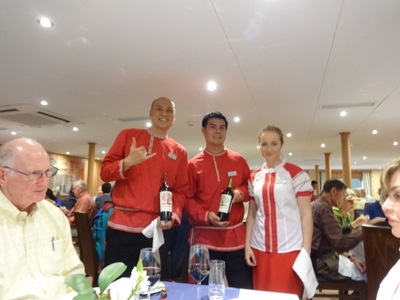 Finally, for the special all-Russian occasion, our wait staff had replaced their usual black-and-white formal clothes for rustic Russian costume. Here are our usual waiters (we always sat near the same place, and therefore saw the same staff at every meal), left to right, Chip, Harvey, and Dasha. Chip and Harvey are both from the Philippines, and Dasha (a nickname for "Daria") is Russian. They were there three times a day, every day, so We asked whether they ever got a day off during the cruising season. No, but Dasha revealed that they occasionally got breakfast off.
Finally, for the special all-Russian occasion, our wait staff had replaced their usual black-and-white formal clothes for rustic Russian costume. Here are our usual waiters (we always sat near the same place, and therefore saw the same staff at every meal), left to right, Chip, Harvey, and Dasha. Chip and Harvey are both from the Philippines, and Dasha (a nickname for "Daria") is Russian. They were there three times a day, every day, so We asked whether they ever got a day off during the cruising season. No, but Dasha revealed that they occasionally got breakfast off.
The evening's entertainment, at 9:30 p.m., was a vodka tasting, which I skipped. Later, Rachel said it had been very informative—she tried eight kinds (ranging, as promised by Andrey, from good to better).